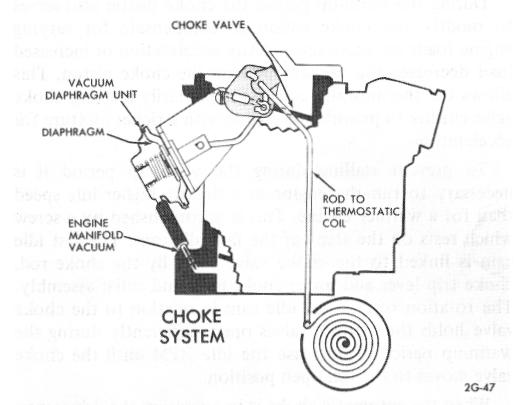9D-3
|
|
|
|
|
|
|
|
|
|
|
|
|
|
MODELS 2G-2GC-2GV PAGE 14
|
|
|
|
|
|
|
|
|
|
|
|
| |
|
|
|
|
|
|
|
|
|
|
|
|
|
| |
|
|
|
|
|
|
|
|
|
|
|
|
|
The constant movement of hot water through the choke outer chamber maintains necessary heat to the choke coil to keep it relaxed and the choke valve wide open.
|
|
|
the choke valve is wide open. At this point, the fast idle screw is completely off the steps of the fast idle cam and the engine returns to normal idle.
|
The polyurethane filter covering the air inlet opening at the side of the choke housing will require periodic cleaning for proper operation. Remove the filter by removing the retaining clip. The filter can be cleaned in cleaning solvent, dried out, and replaced.
|
|
|
MODEL 2GV CHOKE SYSTEM (Fig. 21)
|
|
| |
|
|
|
|
|
|
| |
 |
INTEGRAL CHOKE SYSTEM WITH VACUUM BREAK DIAPHRAGM (2GC) (Fig. 20)
|
|
 |
|
|
| |
|
|
|
|
|
|
|
| |
|
|
|
|
FIGURE 21
|
|
|
| |
|
|
The thermostatic coil located on the engine manifold, and connected to the choke valve by a rod, is calibrated to hold the choke valve closed when the engine is cold. When starting the engine, air velocity against the offset choke valve causes the valve to open slightly against the torque of the thermostatic coil. When the engine is started, manifold vacuum applied to the vacuum diaphragm unit, mounted on the carburetor air horn, will open the choke valve to a point where the engine will operate without loading or stalling. The choke valve will remain in this position (vacuum break) until the engine begins to warm up and heat from the exhaust manifold warms the thermostatic coil to relax its tension and allows the choke valve to gradually open. Opening of the choke valve is controlled by air flow past the offset choke valve, and manifold heat acting upon the thermostatic coil.
|
| |
|
|
|
|
|
|
|
|
| |
|
FIGURE 20
|
|
|
|
|
|
| |
|
|
|
|
|
|
|
|
Some 2GC models use an integral choke mounted on the carburetor but with the choke piston removed and replaced by a vacuum break diaphragm unit. The thermostatic coil rotates a lever in the choke housing which is connected to the choke valve by a rod. Choke operation is controlled by a combination of intake manifold vacuum, the offset choke valve, and engine temperature.
|
|
|
When the engine is started, vacuum is applied to the choke vacuum diaphragm which opens the choke valve against coil tension to a point where the engine will run without loading or stalling lean. The choke valve remains in this position (vacuum break) until the engine begins to warm up and exhaust manifold heat is drawn into the choke housing from the choke stove and begins to relax tension of the choke coil. This allows the choke valve to open gradually through air flow against the offset choke valve and manifold heat acting on the choke coil. This action continues until the engine is warm and the choke valve is fully open.
|
|
|
| |
|
The operation of the 2GV choke system linkage is the same as on the Model 2GC.
|
| |
|
DELAYED VACUUM BREAK SYSTEM (See Figure 22)
|
| |
|
Some 2GC and 2GV carburetors use a delayed vacuum break system. An internal check bleed valve is used in the choke vacuum diaphragm unit to delay the choke valve from opening too fast during cold engine starting. After the engine starts, vacuum is applied through a small bleed in the check valve causing the vacuum break diaphragm plunger to move slowly inward. This gives sufficient time to overcome engine friction and allow the engine manifold to be wetted to prevent a lean stall.
|
To prevent stalling during the warm-up period, it is necessary to run the engine at higher idle speed than a warm engine. This is accomplished through the fast idle screw which rests on steps of the fast idle cam and works directly off a lever attached to the throttle valve shaft. The fast idle cam is attached to the choke valve shaft through connecting linkage. The fast idle cam follows rotation of the choke valve and reduces fast idle speed through the graduated steps on the fast idle cam. This continues until
|
|
|
| |
|
When the vacuum break diaphragm is fully seated (inward) which takes a few seconds, the choke valve will
|